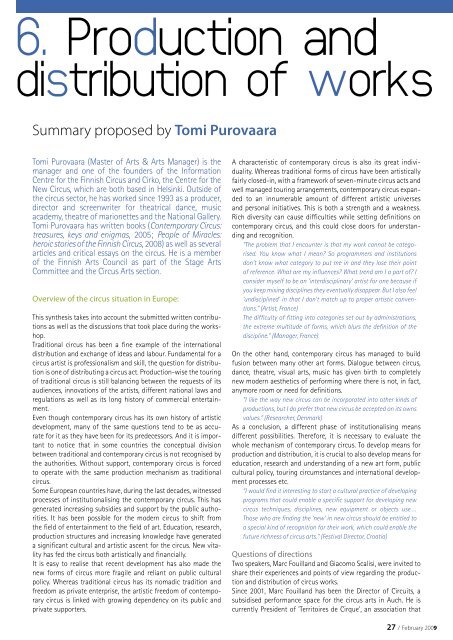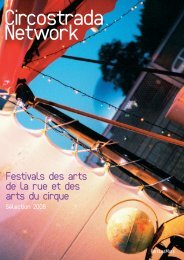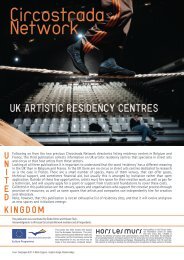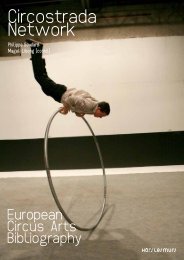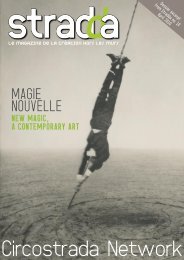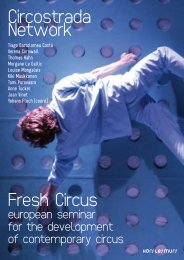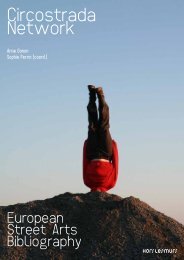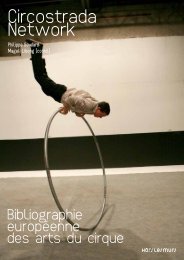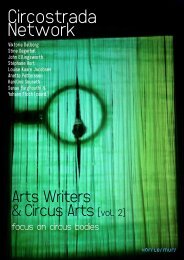Creativity and innovation in the contemporary circus - Circostrada ...
Creativity and innovation in the contemporary circus - Circostrada ...
Creativity and innovation in the contemporary circus - Circostrada ...
You also want an ePaper? Increase the reach of your titles
YUMPU automatically turns print PDFs into web optimized ePapers that Google loves.
6. Production <strong>and</strong>distribution of worksSummary proposed by Tomi PurovaaraTomi Purovaara (Master of Arts & Arts Manager) is <strong>the</strong>manager <strong>and</strong> one of <strong>the</strong> founders of <strong>the</strong> InformationCentre for <strong>the</strong> F<strong>in</strong>nish Circus <strong>and</strong> Cirko, <strong>the</strong> Centre for <strong>the</strong>New Circus, which are both based <strong>in</strong> Hels<strong>in</strong>ki. Outside of<strong>the</strong> <strong>circus</strong> sector, he has worked s<strong>in</strong>ce 1993 as a producer,director <strong>and</strong> screenwriter for <strong>the</strong>atrical dance, musicacademy, <strong>the</strong>atre of marionettes <strong>and</strong> <strong>the</strong> National Gallery.Tomi Purovaara has written books (Contemporary Circus:treasures, keys <strong>and</strong> enigmas, 2005; People of Miracles:heroic stories of <strong>the</strong> F<strong>in</strong>nish Circus, 2008) as well as severalarticles <strong>and</strong> critical essays on <strong>the</strong> <strong>circus</strong>. He is a memberof <strong>the</strong> F<strong>in</strong>nish Arts Council as part of <strong>the</strong> Stage ArtsCommittee <strong>and</strong> <strong>the</strong> Circus Arts section.Overview of <strong>the</strong> <strong>circus</strong> situation <strong>in</strong> Europe:This syn<strong>the</strong>sis takes <strong>in</strong>to account <strong>the</strong> submitted written contributionsas well as <strong>the</strong> discussions that took place dur<strong>in</strong>g <strong>the</strong> workshop.Traditional <strong>circus</strong> has been a f<strong>in</strong>e example of <strong>the</strong> <strong>in</strong>ternationaldistribution <strong>and</strong> exchange of ideas <strong>and</strong> labour. Fundamental for a<strong>circus</strong> artist is professionalism <strong>and</strong> skill, <strong>the</strong> question for distributionis one of distribut<strong>in</strong>g a <strong>circus</strong> act. Production-wise <strong>the</strong> tour<strong>in</strong>gof traditional <strong>circus</strong> is still balanc<strong>in</strong>g between <strong>the</strong> requests of itsaudiences, <strong><strong>in</strong>novation</strong>s of <strong>the</strong> artists, different national laws <strong>and</strong>regulations as well as its long history of commercial enterta<strong>in</strong>ment.Even though <strong>contemporary</strong> <strong>circus</strong> has its own history of artisticdevelopment, many of <strong>the</strong> same questions tend to be as accuratefor it as <strong>the</strong>y have been for its predecessors. And it is importantto notice that <strong>in</strong> some countries <strong>the</strong> conceptual divisionbetween traditional <strong>and</strong> <strong>contemporary</strong> <strong>circus</strong> is not recognised by<strong>the</strong> authorities. Without support, <strong>contemporary</strong> <strong>circus</strong> is forcedto operate with <strong>the</strong> same production mechanism as traditional<strong>circus</strong>.Some European countries have, dur<strong>in</strong>g <strong>the</strong> last decades, witnessedprocesses of <strong>in</strong>stitutionalis<strong>in</strong>g <strong>the</strong> <strong>contemporary</strong> <strong>circus</strong>. This hasgenerated <strong>in</strong>creas<strong>in</strong>g subsidies <strong>and</strong> support by <strong>the</strong> public authorities.It has been possible for <strong>the</strong> modern <strong>circus</strong> to shift from<strong>the</strong> field of enterta<strong>in</strong>ment to <strong>the</strong> field of art. Education, research,production structures <strong>and</strong> <strong>in</strong>creas<strong>in</strong>g knowledge have generateda significant cultural <strong>and</strong> artistic ascent for <strong>the</strong> <strong>circus</strong>. New vitalityhas fed <strong>the</strong> <strong>circus</strong> both artistically <strong>and</strong> f<strong>in</strong>ancially.It is easy to realise that recent development has also made <strong>the</strong>new forms of <strong>circus</strong> more fragile <strong>and</strong> reliant on public culturalpolicy. Whereas traditional <strong>circus</strong> has its nomadic tradition <strong>and</strong>freedom as private enterprise, <strong>the</strong> artistic freedom of <strong>contemporary</strong><strong>circus</strong> is l<strong>in</strong>ked with grow<strong>in</strong>g dependency on its public <strong>and</strong>private supporters.A characteristic of <strong>contemporary</strong> <strong>circus</strong> is also its great <strong>in</strong>dividuality.Whereas traditional forms of <strong>circus</strong> have been artisticallyfairly closed-<strong>in</strong>, with a framework of seven-m<strong>in</strong>ute <strong>circus</strong> acts <strong>and</strong>well managed tour<strong>in</strong>g arrangements, <strong>contemporary</strong> <strong>circus</strong> exp<strong>and</strong>edto an <strong>in</strong>numerable amount of different artistic universes<strong>and</strong> personal <strong>in</strong>itiatives. This is both a strength <strong>and</strong> a weakness.Rich diversity can cause difficulties while sett<strong>in</strong>g def<strong>in</strong>itions on<strong>contemporary</strong> <strong>circus</strong>, <strong>and</strong> this could close doors for underst<strong>and</strong><strong>in</strong>g<strong>and</strong> recognition.“The problem that I encounter is that my work cannot be categorised.You know what I mean? So programmers <strong>and</strong> <strong>in</strong>stitutionsdon’t know what category to put me <strong>in</strong> <strong>and</strong> <strong>the</strong>y lose <strong>the</strong>ir po<strong>in</strong>tof reference. What are my <strong>in</strong>fluences? What trend am I a part of? Iconsider myself to be an ‘<strong>in</strong>terdiscipl<strong>in</strong>ary’ artist for one because ifyou keep mix<strong>in</strong>g discipl<strong>in</strong>es <strong>the</strong>y eventually disappear. But I also feel‘undiscipl<strong>in</strong>ed’ <strong>in</strong> that I don’t match up to proper artistic conventions.”(Artist, France)The difficulty of fitt<strong>in</strong>g <strong>in</strong>to categories set out by adm<strong>in</strong>istrations,<strong>the</strong> extreme multitude of forms, which blurs <strong>the</strong> def<strong>in</strong>ition of <strong>the</strong>discipl<strong>in</strong>e.” (Manager, France)On <strong>the</strong> o<strong>the</strong>r h<strong>and</strong>, <strong>contemporary</strong> <strong>circus</strong> has managed to buildfusion between many o<strong>the</strong>r art forms. Dialogue between <strong>circus</strong>,dance, <strong>the</strong>atre, visual arts, music has given birth to completelynew modern aes<strong>the</strong>tics of perform<strong>in</strong>g where <strong>the</strong>re is not, <strong>in</strong> fact,anymore room or need for def<strong>in</strong>itions.“I like <strong>the</strong> way new <strong>circus</strong> can be <strong>in</strong>corporated <strong>in</strong>to o<strong>the</strong>r k<strong>in</strong>ds ofproductions, but I do prefer that new <strong>circus</strong> be accepted on its ownsvalues.” (Researcher, Denmark)As a conclusion, a different phase of <strong>in</strong>stitutionalis<strong>in</strong>g meansdifferent possibilities. Therefore, it is necessary to evaluate <strong>the</strong>whole mechanism of <strong>contemporary</strong> <strong>circus</strong>. To develop means forproduction <strong>and</strong> distribution, it is crucial to also develop means foreducation, research <strong>and</strong> underst<strong>and</strong><strong>in</strong>g of a new art form, publiccultural policy, tour<strong>in</strong>g circumstances <strong>and</strong> <strong>in</strong>ternational developmentprocesses etc.“I would f<strong>in</strong>d it <strong>in</strong>terest<strong>in</strong>g to start a cultural practice of develop<strong>in</strong>gprograms that could enable a specific support for develop<strong>in</strong>g new<strong>circus</strong> techniques, discipl<strong>in</strong>es, new equipment or objects use …Those who are f<strong>in</strong>d<strong>in</strong>g <strong>the</strong> ‘new’ <strong>in</strong> new <strong>circus</strong> should be entitled toa special k<strong>in</strong>d of recognition for <strong>the</strong>ir work, which could enable <strong>the</strong>future richness of <strong>circus</strong> arts.” (Festival Director, Croatia)Questions of directionsTwo speakers, Marc Fouill<strong>and</strong> <strong>and</strong> Giacomo Scalisi, were <strong>in</strong>vited toshare <strong>the</strong>ir experiences <strong>and</strong> po<strong>in</strong>ts of view regard<strong>in</strong>g <strong>the</strong> production<strong>and</strong> distribution of <strong>circus</strong> works.S<strong>in</strong>ce 2001, Marc Fouill<strong>and</strong> has been <strong>the</strong> Director of Circuits, asubsidised performance space for <strong>the</strong> <strong>circus</strong> arts <strong>in</strong> Auch. He iscurrently President of 'Territoires de Cirque', an association that27 / February 2009


